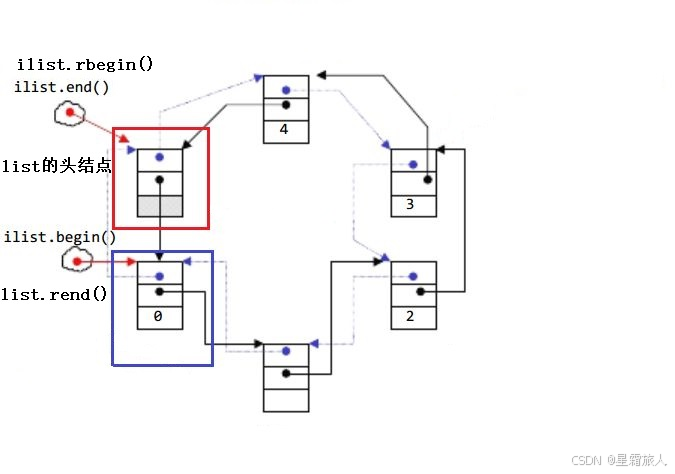凭时间赢来的东西,时间肯定会为之作证。
前言
这是我自己学习C++的第七篇博客总结。后期我会继续把C++学习笔记开源至博客上。
上一期笔记是关于C++的vector类知识,没看的同学可以过去看看:【C++】探索Vector:灵活的数据存储解决方案-CSDN博客
https://blog.csdn.net/hsy1603914691/article/details/145553176
list类的介绍
- 在使用list类 时,必须包含**#include <list>** 这一行。
2.string类 的底层其实是一个储存字符的顺序表结构 ,而vector类 的底层是一个顺序表模板 ,使用时需要显示实例化 ,而list类 的底层是一个双向链表模板 ,使用时也需要显示实例化 ,后面的笔记中以整形 为例。
- 下面是list类 的官方文本介绍,里面有详细的用法讲解。
cplusplus.com/reference/list/list/?kw=list
https://cplusplus.com/reference/list/list/?kw=list

list类对象的常见构造
1.list<int> l1 ,什么也不需要传入,构造一个空的list类对象。
2.list<int> l2(n,num) ,构造一个list类对象,里面包含n个num整形。
3.list<int> l3(l2.begin(),l2.end()) ,使用另一个list类对象进行迭代器构造。
- list<int> l4(l3) ,使用另一个list类对象进行构造。
cpp
#define _CRT_SECURE_NO_WARNINGS
#include <iostream>
#include <list>
using namespace std;
int main()
{
list<int> l1;
list<int> l2(5, 1);
list<int> l3(l2.begin(), l2.end());
list<int> l4(l3);
for (auto a : l1)
{
cout << a << " ";
}
cout << endl;
for (auto a : l2)
{
cout << a << " ";
}
cout << endl;
for (auto a : l3)
{
cout << a << " ";
}
cout << endl;
for (auto a : l4)
{
cout << a << " ";
}
cout << endl;
return 0;
}
//
//1 1 1 1 1
//1 1 1 1 1
//1 1 1 1 1
list类对象的初始化分为两种。
如果使用**=号,则为拷贝初始化**;如果不使用**=号,则为直接初始化**。
list类对象的初始化时,需要使用大括号包裹初始化值。
cpp
#define _CRT_SECURE_NO_WARNINGS
#include <iostream>
#include <list>
using namespace std;
int main()
{
list<int> l1 = { 1,2,3,4,5 };
list<int> l2({ 5,6,7,8,9 });
for (auto a : l1)
{
cout << a << " ";
}
cout << endl;
for (auto a : l2)
{
cout << a << " ";
}
cout << endl;
return 0;
}list类对象的容量操作
- list.size() ,返回list类对象 中有效节点 的个数。
2.list.empty() ,检测list类对象的有效大小是否为0,为0返回true,不为0返回flase。
cpp
#define _CRT_SECURE_NO_WARNINGS
#include <iostream>
#include <list>
using namespace std;
int main()
{
list<int> l1 = { 1,2,3,4,5 };
list<int> l2({ 5,6,7,8,9 });
cout << l1.size() << endl;//5
cout << l2.empty() << endl;//0
return 0;
}list类对象的修改操作
1.list.push_back(num) ,在list类对象中尾插整数num。
- list.pop_back(),在list类对象中尾删。
3.list.push_front(num) ,在list类对象的首元素之前****插入 一个元素num 。
- list.pop front(),删除list类对象的首元素 。
5.list.insert(pos_iterator,n,num)****,在下标为pos位置的元素的前面插入n个数字num。
list.erase(pos_iterator),删除下标为pos位置的元素的上的数字,如果需要删除一串数字,则再给一个截至迭代器。
list.swap(v2),交换两个list类对象的值****。
list类对象的返回值操作
list.front(),返回list类对象的第一个节点 的值引用 。
list.back(),返回list类对象的最后一个节点 的值引用 。
cpp
#define _CRT_SECURE_NO_WARNINGS
#include <iostream>
#include <list>
using namespace std;
int main()
{
list<int> l1 = { 1,2,3,4,5 };
cout << l1.front() << endl;
cout << l1.back() << endl;
return 0;
}list类对象的遍历操作
由于vector类对象 和string类对象 的底层都是顺序表 ,所以**[ ]** 都可以进行重构 ;而list类对象 的底层是链表 ,所以**[ ]** 不能进行重构,即无法使用 。
list.begin() 、list.end() ,vector.begin() 获取第一个节点的迭代器,string.end() 获取最后一个节点的下一个位置的迭代器。
list.rbegin() 、list.rend() ,list.rbegin() 获取头节点 的迭代器,vector.rend()获取第一个节点 的迭代器。
注意反向迭代器 进行迭代的步骤也是**++** ,反向迭代器是用来反向遍历链表 的。
范围for循环 ,用于有范围的集合进行遍历,C++11 中引入了基于范围的for循环 。for循环 中的括号由冒号" : " 分为两部分:第一部分是用于迭代的变量 (可以使用auto 让编译器自动判断变量类型),第二部分则表示被迭代的范围 。(自动迭代,自动取数据,自动判断结束。 )
范围for循环 ,如果需要对范围对象进行修改 ,则使用auto& 来修饰迭代的变量;如果需要对较大的目标对象进行遍历 ,也可以使用auto& 来修饰迭代的变量。
范围for循环 ,是用于遍历容器的,它的底层也是迭代器 。(数组也可以用范围for循环。 )

cpp
//迭代器
#define _CRT_SECURE_NO_WARNINGS
#include <iostream>
#include <list>
using namespace std;
int main()
{
list<int> l1 = { 1,2,3,4,5 };
auto lt = l1.begin();
while (lt != l1.end())
{
cout << *lt << " ";
lt++;
}
return 0;
}
cpp
//反向迭代器
#define _CRT_SECURE_NO_WARNINGS
#include <iostream>
#include <list>
using namespace std;
int main()
{
list<int> l1 = { 1,2,3,4,5 };
auto lt = l1.rbegin();
while (lt != l1.rend())
{
cout << *lt << " ";
lt++;
}
return 0;
}
cpp
//for循环
#define _CRT_SECURE_NO_WARNINGS
#include <iostream>
#include <list>
using namespace std;
int main()
{
list<int> l1 = { 1,2,3,4,5 };
list<int> l2({ 5,6,7,8,9 });
for (auto a : l1)
{
cout << a << " ";
}
cout << endl;
for (auto& a : l2)
{
cout << a << " ";
}
cout << endl;
return 0;
}致谢
感谢您花时间阅读这篇文章!如果您对本文有任何疑问、建议或是想要分享您的看法,请不要犹豫,在评论区留下您的宝贵意见。每一次互动都是我前进的动力,您的支持是我最大的鼓励。期待与您的交流,让我们共同成长,探索技术世界的无限可能!